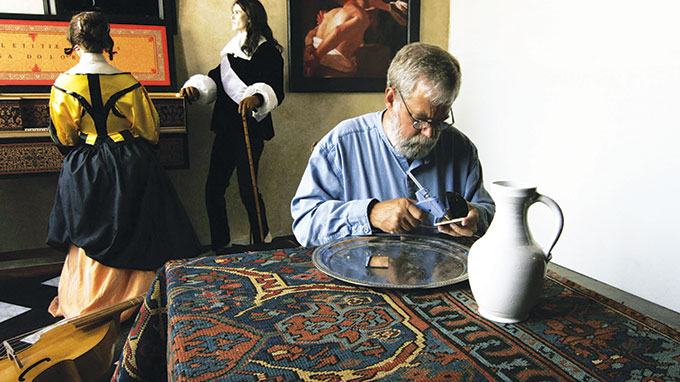Tim's Vermeer
by M. Faust

It was done with mirrors. That’s Tim Jenison’s theory as to how the Dutch master Johannes Vermeer (1632-1675) was able to produce oil paintings that even today are startling for their almost photographic realism.
Jenison is neither a painter nor an art historian. He’s an inventor who made a lot of money with his company NewTek, a 1980s pioneer in computer graphics and digital video. He continues to tinker, following whatever interests him. When his daughter gave him a copy of David Hockney’s book Secret Knowledge, he became obsessed with Hockney’s theory that Vermeer and other painters of his era used gadgets like the camera obscura to help them reproduce shapes in exact proportion.
Trying to put that theory into practice, Jenison decided that tracing alone couldn’t account for such painstaking detail. He came up with a device using basic mirrors and other easily available materials that allowed the painter to have small portions of what he wanted to paint at his fingertips, the better to copy it. And to prove that this could have been done, he used his method to re-create Vermeer’s The Music Room.
That this process is painstakingly documented is the result of Jenison’s life-long friendship with Penn Jillette, better known as one-half of the comedy/magic duo Penn and Teller. The two are equally as well known for the work as professional debunkers, best seen on their Showtime series Bullshit! They argue that their purpose in filming Jenison’s efforts was not to deride Vermeer’s achievements; showing how he might have worked, Penn argues, merely changes his nature in our eyes from an “unfathomable genius” to that of a “fathomable genius.”
To that end, it would have been nice if the film included a few naysayers to present an opposite point of view, to compare Jenison’s finished work with the original painting and discuss the differences.
Still, Tim’s Vermeer shows that even if the real Vermeer used this process, it hardly made his work simple: It takes Jenison months of painstaking labor to capture all the details of objects that Vermeer chose to include in his painting. (Equally as impressive are Jenison’s efforts to rebuild the setting of the painting, all by hand.) Despite touches of humor from Jillette, whose usual abrasiveness is toned down here, the film is largely about watching paint dry—and you’ll be amazed at how engrossing that can be.
Watch the trailer for Tim's Vermeer
|
Issue Navigation> Issue Index > v13n11 (Week of Thursday, March 13) > Film Reviews > Tim's Vermeer This Week's Issue • Artvoice Daily • Artvoice TV • Events Calendar • Classifieds |









 Current Issue
Current Issue